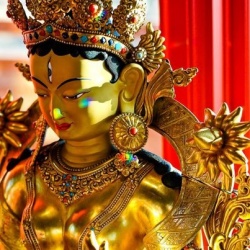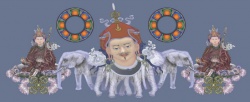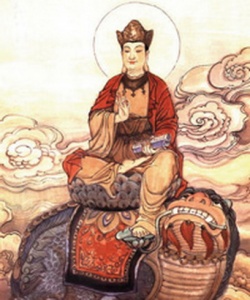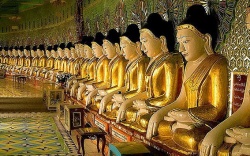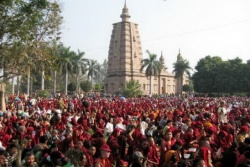Difference between revisions of "Mountain Gods Worshipped by the Tibetans"
(Created page with " <poem> In Tibetan-inhabited areas, people have long believed that deities live at the top of high mountains and there are many {{Wiki|legends}} regarding them. I...") |
|||
| Line 1: | Line 1: | ||
| − | + | {{DisplayImages|2678|1561|1223|679|2261}} | |
<poem> | <poem> | ||
In Tibetan-inhabited areas, [[people]] have long believed that [[deities]] live at the top of high [[mountains]] and there are many {{Wiki|legends}} regarding them. In the [[eyes]] of the [[Tibetans]], these [[mountain gods]] have their various special roles. Older [[people]] {{Wiki|worship}} them and make [[offerings]] in the {{Wiki|hope}} of living a long and healthy [[life]], while young men {{Wiki|hope}} they will become more handsome and girls more beautiful; herders pray for the possession of large numbers of cattle and sheep while {{Wiki|farmers}} seek bumper harvests. | In Tibetan-inhabited areas, [[people]] have long believed that [[deities]] live at the top of high [[mountains]] and there are many {{Wiki|legends}} regarding them. In the [[eyes]] of the [[Tibetans]], these [[mountain gods]] have their various special roles. Older [[people]] {{Wiki|worship}} them and make [[offerings]] in the {{Wiki|hope}} of living a long and healthy [[life]], while young men {{Wiki|hope}} they will become more handsome and girls more beautiful; herders pray for the possession of large numbers of cattle and sheep while {{Wiki|farmers}} seek bumper harvests. | ||
| Line 7: | Line 7: | ||
The early predecessors of the {{Wiki|present}} [[Tibetan]] race [[thought]] that there were [[gods]] on each mountaintop who controlled the [[wind]], [[rain]], [[thunder]], as well as the [[hunting]], and harvesting. | The early predecessors of the {{Wiki|present}} [[Tibetan]] race [[thought]] that there were [[gods]] on each mountaintop who controlled the [[wind]], [[rain]], [[thunder]], as well as the [[hunting]], and harvesting. | ||
| − | Today, there are still some [[Tibetan]] taboos related to the moods of the [[mountain gods]]. For example, when [[people]] pass by high [[mountains]], valleys, cliffs and original forests, they shouldn't make much noise; if offended the [[mountain gods]] can [[cause]] [[violent]] storms with lightening, or even mountain torrents and avalanches. In the period of Tsampo Zhigung of the [[Tubo]] {{Wiki|Kingdom}} (ca AD200), the [[Bon religion]] was introduced from [[Zhangzhung]], and the [[mountain gods]] that formed part of the original natural {{Wiki|worship}} of the predecessors of the [[Tibetans]] expanded. From then on, the [[gods]] were said to control the order of [[nature]], [[human]] [[birth]] and [[death]], and even the spread or elimination of plague. | + | Today, there are still some [[Tibetan]] taboos related to the moods of the [[mountain gods]]. For example, when [[people]] pass by high [[mountains]], valleys, cliffs and original forests, they shouldn't make much noise; if offended the [[mountain gods]] can [[cause]] [[violent]] storms with lightening, or even mountain torrents and avalanches. In the period of [[Tsampo Zhigung]] of the [[Tubo]] {{Wiki|Kingdom}} (ca AD200), the [[Bon religion]] was introduced from [[Zhangzhung]], and the [[mountain gods]] that formed part of the original natural {{Wiki|worship}} of the predecessors of the [[Tibetans]] expanded. From then on, the [[gods]] were said to control the order of [[nature]], [[human]] [[birth]] and [[death]], and even the spread or elimination of plague. |
| − | {{Wiki|Tibetan people}} think that in the Tibetan-inhabited areas there are four great [[holy mountains]]: Yalhashangbo in [[U-Tsang]] areas, Nyangqentanglha in the [[north]], Kulharigyi in the [[south]] and Wodegonggyi in the [[east]]. | + | {{Wiki|Tibetan people}} think that in the Tibetan-inhabited areas there are four great [[holy mountains]]: [[Yalhashangbo]] in [[U-Tsang]] areas, [[Nyangqentanglha]] in the [[north]], [[Kulharigyi]] in the [[south]] and [[Wodegonggyi]] in the [[east]]. |
| − | Four great [[mountain gods]], as well as another five famous ones, make up the core of the system, which is called "nine [[gods]] forming the [[world]]". These nine [[mountain gods]] are Wodegonggyia, Yalhashangbo, Nyangqentanglha, Nganyimaqen, Choqentunri, Gangbalhari, Sholhachubo, Chowoyugyia, and Siwokari. In addition, because of different geographical [[conditions]], each area has its own particular local [[mountain gods]], such as [[holy mountains]] in Gangdese in {{Wiki|western}} [[Tibet]] and the Five-Longevity Sisters in the [[Tingri]] district. | + | Four great [[mountain gods]], as well as another five famous ones, make up the core of the system, which is called "nine [[gods]] forming the [[world]]". These nine [[mountain gods]] are [[Wodegonggyia]], [[Yalhashangbo]], [[Nyangqentanglha]], [[Nganyimaqen]], [[Choqentunri]], [[Gangbalhari]], [[Sholhachubo]], [[Chowoyugyia]], and [[Siwokari]]. In addition, because of different geographical [[conditions]], each area has its own particular local [[mountain gods]], such as [[holy mountains]] in Gangdese in {{Wiki|western}} [[Tibet]] and the Five-Longevity Sisters in the [[Tingri]] district. |
| − | There are many {{Wiki|legends}} about [[mountain gods]], and what follows is the story of Nganyimaqen. | + | There are many {{Wiki|legends}} about [[mountain gods]], and what follows is the story of [[Nganyimaqen]]. |
| − | Long ago, there was an old man named Wodegonggyia. In order to release the [[people]] in the Tibetan-inhabited areas from {{Wiki|disaster}}, he sent his eight sons to help them. Seven of them went to [[north]] of [[Tibet]] and {{Wiki|Khamba}}, and the fourth son was sent to [[Amdo]]. On his departure, the old man told the fourth son: "Be kind to [[people]] with braids on their head as fathers; be kind to [[people]] with decorations on their back as mothers; be kind to young [[people]] of your own age as brothers. Only by doing so will you become the strongest [[person]] in the [[world]]. Only by winning the [[confidence]] and help of the [[Amdo]] [[people]] can you succeed." They then pledged to meet in [[Amdo]] in the Year of the | + | Long ago, there was an old man named [[Wodegonggyia]]. In order to release the [[people]] in the Tibetan-inhabited areas from {{Wiki|disaster}}, he sent his eight sons to help them. Seven of them went to [[north]] of [[Tibet]] and {{Wiki|Khamba}}, and the fourth son was sent to [[Amdo]]. On his departure, the old man told the fourth son: "Be kind to [[people]] with braids on their head as fathers; be kind to [[people]] with decorations on their back as mothers; be kind to young [[people]] of your own age as brothers. Only by doing so will you become the strongest [[person]] in the [[world]]. Only by winning the [[confidence]] and help of the [[Amdo]] [[people]] can you succeed." They then pledged to meet in [[Amdo]] in the [[Year of the Horse]]. |
The young man tramped over 99 [[mountains]], 99 [[rivers]] and 99 grasslands before arriving in [[Amdo]], where, due to the presence of [[devils]], in summer there were floods, {{Wiki|beasts}} of prey haunted the [[mountains]] and [[evil]] men hurt the common [[people]]... | The young man tramped over 99 [[mountains]], 99 [[rivers]] and 99 grasslands before arriving in [[Amdo]], where, due to the presence of [[devils]], in summer there were floods, {{Wiki|beasts}} of prey haunted the [[mountains]] and [[evil]] men hurt the common [[people]]... | ||
| Line 21: | Line 21: | ||
The young man annihilated the [[devils]], subdued the {{Wiki|beasts}} of prey, and punished [[evil]] men, so [[people]] in [[Amdo]] were able to begin living [[peaceful]] [[lives]]. He gained the people's [[love]] and esteem, and was elected as their leader. He was also made a [[Buddhist]] guardian by the [[gods]] and controlled the [[mountains]] and [[rivers]] in [[Amdo]]. | The young man annihilated the [[devils]], subdued the {{Wiki|beasts}} of prey, and punished [[evil]] men, so [[people]] in [[Amdo]] were able to begin living [[peaceful]] [[lives]]. He gained the people's [[love]] and esteem, and was elected as their leader. He was also made a [[Buddhist]] guardian by the [[gods]] and controlled the [[mountains]] and [[rivers]] in [[Amdo]]. | ||
| − | In the Year of the | + | In the [[Year of the Horse]], on the day when father met the son, 1,500 mounted knights with [[human]] [[bodies]] and the heads of {{Wiki|beasts}}, carrying broadswords and pikes, received [[Wodegonggyia]] at the source of the {{Wiki|Yellow River}}. Everyone in [[Amdo]] [[gathered]] around the palace to welcome them. |
| − | Wodegonggyia and his son met the [[people]] outside the palace and all [[people]] brought fresh zanba, buttered tea, freshly boiled mutton, and qingke wine as an [[offering]]. [[People]] [[sang]] and danced to their heart's content. | + | [[Wodegonggyia]] and his son met the [[people]] outside the palace and all [[people]] brought fresh [[zanba]], buttered tea, freshly boiled mutton, and [[qingke]] wine as an [[offering]]. [[People]] [[sang]] and danced to their heart's content. |
Suddenly there came the [[sound]] of [[thunder]] and the palace rose into the clouds. | Suddenly there came the [[sound]] of [[thunder]] and the palace rose into the clouds. | ||
| − | In order to remember their [[hero]], the local [[people]] called the nearby [[snow mountain]] as "Nganyimaqen" and every [[Tibetan]] Year of the [[Horse]], [[people]] would come to attend "Sibaqihe Lha Gully" and {{Wiki|worship}} the embodiments of Wodegonggyia and his son. | + | In order to remember their [[hero]], the local [[people]] called the nearby [[snow mountain]] as "[[Nganyimaqen]]" and every [[Tibetan]] Year of the [[Horse]], [[people]] would come to attend "Sibaqihe Lha Gully" and {{Wiki|worship}} the embodiments of Wodegonggyia and his son. |
| − | Nganyimaqen is the [[name]] by which it is called by local, who speak of the Nganyimaqen mountain [[god]] or Bomuqinmure. It lies on southern bank of {{Wiki|Qinghai Lake}}. It is said that there were 360 brother [[deities]] accompanying the mountain [[god]] in Nganyimaqen, who are called the 360 "Mar" for short. On the left arm of the Nganyimaqen mountain [[god]] there was a bag made of eagle's {{Wiki|skin}}; he rode on a [[Wikipedia:White horse (mythology)|white horse]] (some say a [[lion]]). | + | [[Nganyimaqen]] is the [[name]] by which it is called by local, who speak of the [[Nganyimaqen]] mountain [[god]] or [[Bomuqinmure]]. It lies on southern bank of {{Wiki|Qinghai Lake}}. It is said that there were 360 brother [[deities]] accompanying the mountain [[god]] in [[Nganyimaqen]], who are called the 360 "Mar" for short. On the left arm of the [[Nganyimaqen]] mountain [[god]] there was a bag made of eagle's {{Wiki|skin}}; he rode on a [[Wikipedia:White horse (mythology)|white horse]] (some say a [[lion]]). |
| − | Yalhashangbo mountain [[god]] lived on Yalhashangbo Mountain in [[Yarlung]] and was the leader of all the [[local deities]], and was later absorbed as a [[Buddhist]] guardian by [[Padmasambhava]]. He is always portrayed as a figure in white [[clothes]] riding on a white yak and with an avalanche spewing from his {{Wiki|mouth}}, and was regarded as second among the "nine [[mountain gods]] forming the [[world]]", next only to Wodegonggyia. | + | [[Yalhashangbo]] mountain [[god]] lived on [[Yalhashangbo]] Mountain in [[Yarlung]] and was the leader of all the [[local deities]], and was later absorbed as a [[Buddhist]] guardian by [[Padmasambhava]]. He is always portrayed as a figure in white [[clothes]] riding on a white yak and with an avalanche spewing from his {{Wiki|mouth}}, and was regarded as second among the "nine [[mountain gods]] forming the [[world]]", next only to [[Wodegonggyia]]. |
| − | According to local {{Wiki|legends}}, the Yalhashangbo mountain [[god]] was a white yak with a [[constant]] avalanche [[emerging]] from its {{Wiki|mouth}} and {{Wiki|nose}}. It could destroy rocks, [[caused]] floods and could even make [[love]] with common [[people]] to give [[birth]]. As the [[highest]] [[deity]], the [[mountain gods]] led all the local protective [[gods]] and [[earth]] [[gods]] in [[Yarlung]]. The Yalhashangbo mountain [[god]] had a wife and children, his spouse being leader of the [[female deities]] who dressed in pink, carried lightening in her right hand and hail in her left, and flew on a lightening bolt. | + | According to local {{Wiki|legends}}, the [[Yalhashangbo]] mountain [[god]] was a white yak with a [[constant]] avalanche [[emerging]] from its {{Wiki|mouth}} and {{Wiki|nose}}. It could destroy rocks, [[caused]] floods and could even make [[love]] with common [[people]] to give [[birth]]. As the [[highest]] [[deity]], the [[mountain gods]] led all the local protective [[gods]] and [[earth]] [[gods]] in [[Yarlung]]. The [[Yalhashangbo]] mountain [[god]] had a wife and children, his spouse being leader of the [[female deities]] who dressed in pink, carried lightening in her right hand and hail in her left, and flew on a lightening bolt. |
| − | The Nyangqentanglha mountain [[god]] was the leading [[deity]] in the Nyangqentanglha [[Mountains]] extending hundreds of km through the wilderness of northern [[Tibet]]. The Nyangqentanglha mountain [[god]] was among the "18 [[deities]] in charge of hail". It comes of three [[incarnated]] shapes: the first is a [[person]] dressed in white with a white kerchief on the head, holding a horsewhip in the right hand and a short sword in the left, riding on a [[Wikipedia:White horse (mythology)|white horse]]; the second is dressed in armor made of refined [[jade]] and a black bear {{Wiki|skin}}, wearing a helmet made of refined [[jade]] and carrying a cold shining {{Wiki|iron}} sword; the third one is dressed in {{Wiki|crystal}} armor and has a white {{Wiki|crystal}} pike. | + | The [[Nyangqentanglha]] mountain [[god]] was the leading [[deity]] in the [[Nyangqentanglha]] [[Mountains]] extending hundreds of km through the wilderness of northern [[Tibet]]. The [[Nyangqentanglha]] mountain [[god]] was among the "18 [[deities]] in charge of hail". It comes of three [[incarnated]] shapes: the first is a [[person]] dressed in white with a white kerchief on the head, holding a horsewhip in the right hand and a short sword in the left, riding on a [[Wikipedia:White horse (mythology)|white horse]]; the second is dressed in armor made of refined [[jade]] and a black bear {{Wiki|skin}}, wearing a helmet made of refined [[jade]] and carrying a cold shining {{Wiki|iron}} sword; the third one is dressed in {{Wiki|crystal}} armor and has a white {{Wiki|crystal}} pike. |
| − | When [[people]] passed Tanggulha Mountain, they would burn [[joss sticks]] and offer various sacrifices to the [[mountain gods]]. In {{Wiki|legends}}, Nyangqentanglha [[mountain gods]] were also viewed as protective [[gods]] of [[money]] and valuables. | + | When [[people]] passed [[Tanggulha]] Mountain, they would burn [[joss sticks]] and offer various sacrifices to the [[mountain gods]]. In {{Wiki|legends}}, [[Nyangqentanglha]] [[mountain gods]] were also viewed as protective [[gods]] of [[money]] and valuables. |
| − | Kangrenboqe occupies an important place in the hearts of herders in northern [[Tibet]]. In the {{Wiki|past}}, herders of the [[Amdo]] Dorma tribe often went to Kangrenboqe Mountain with their families and spent several months or several years on the way or even lived for a long [[time]] in Kangrenboqe. Herders often take [[ritual]] walks around Kangrenboqe in the [[Tibetan]] Year of the [[Tiger]] and Zari in the [[Tibetan]] Year of the Monkey. | + | [[Kangrenboqe]] occupies an important place in the hearts of herders in northern [[Tibet]]. In the {{Wiki|past}}, herders of the [[Amdo]] [[Dorma]] tribe often went to [[Kangrenboqe]] Mountain with their families and spent several months or several years on the way or even lived for a long [[time]] in [[Kangrenboqe]]. Herders often take [[ritual]] walks around [[Kangrenboqe]] in the [[Tibetan]] Year of the [[Tiger]] and [[Zari]] in the [[Tibetan]] [[Year of the Monkey]]. |
| − | During the 7th and 8th months in the [[Tibetan calendar]], [[Amdo]] Dorma herders take [[ritual]] walks around a [[holy mountain]]. According to {{Wiki|custom}}, only men can perform this [[ritual]]... Before starting, they will invite [[monks]] to [[chant]] [[sutras]], and then they ride on horseback or walk around [[holy mountains]] {{Wiki|clockwise}}. During the progression, they will burn aromatic [[plants]], place engraved Mani stones, offer hada to the [[holy mountains]], and scatter or place butter, milk dregs, ox [[hair]] ropes, [[Tibetan]] knives, or even {{Wiki|silver}}, {{Wiki|coral}}, agate as a sign of {{Wiki|worship}}. | + | During the 7th and 8th months in the [[Tibetan calendar]], [[Amdo]] [[Dorma]] herders take [[ritual]] walks around a [[holy mountain]]. According to {{Wiki|custom}}, only men can perform this [[ritual]]... Before starting, they will invite [[monks]] to [[chant]] [[sutras]], and then they ride on horseback or walk around [[holy mountains]] {{Wiki|clockwise}}. During the progression, they will burn aromatic [[plants]], place engraved Mani stones, offer hada to the [[holy mountains]], and scatter or place butter, milk dregs, ox [[hair]] ropes, [[Tibetan]] knives, or even {{Wiki|silver}}, {{Wiki|coral}}, agate as a sign of {{Wiki|worship}}. |
| − | Herders in [[Amdo]] Dorma tribe do not hunt on the [[holy mountains]], but [[plants]] and {{Wiki|minerals}} can be collected to make [[Tibetan medicines]] with great curative effect. But before collection, they must pray and burn aromatic [[plants]]. Some herders will kowtow and {{Wiki|worship}} [[holy mountains]] every evening. | + | Herders in [[Amdo]] [[Dorma]] tribe do not hunt on the [[holy mountains]], but [[plants]] and {{Wiki|minerals}} can be collected to make [[Tibetan medicines]] with great curative effect. But before collection, they must pray and burn aromatic [[plants]]. Some herders will kowtow and {{Wiki|worship}} [[holy mountains]] every evening. |
In [[Tibet]], {{Wiki|holy}} {{Wiki|palaces}} to {{Wiki|worship}} [[mountain gods]] can found everywhere. Fluttering [[sutra]] streamers and aromatic smoke give you a great [[feeling]] that you are protected and blessed by the [[mountain gods]]. | In [[Tibet]], {{Wiki|holy}} {{Wiki|palaces}} to {{Wiki|worship}} [[mountain gods]] can found everywhere. Fluttering [[sutra]] streamers and aromatic smoke give you a great [[feeling]] that you are protected and blessed by the [[mountain gods]]. | ||
Latest revision as of 14:05, 20 March 2014
In Tibetan-inhabited areas, people have long believed that deities live at the top of high mountains and there are many legends regarding them. In the eyes of the Tibetans, these mountain gods have their various special roles. Older people worship them and make offerings in the hope of living a long and healthy life, while young men hope they will become more handsome and girls more beautiful; herders pray for the possession of large numbers of cattle and sheep while farmers seek bumper harvests.
An old herder in North Tibet said: "Mountains god are worshiped because they can control the forces of nature such as wind, rain, snow and hail, can protect us and ensure our good health and ensure our livestock prosper; but, they can also cause disaster and so endanger us. But, mountain gods are easier to be enraged than any other deity. Don't enrage them. Mountain gods always live in the mountains and high valleys in the image of hunters on a horse. It is easy to meet them face to face. If you offend them, you will get sick and even die."
The early predecessors of the present Tibetan race thought that there were gods on each mountaintop who controlled the wind, rain, thunder, as well as the hunting, and harvesting.
Today, there are still some Tibetan taboos related to the moods of the mountain gods. For example, when people pass by high mountains, valleys, cliffs and original forests, they shouldn't make much noise; if offended the mountain gods can cause violent storms with lightening, or even mountain torrents and avalanches. In the period of Tsampo Zhigung of the Tubo Kingdom (ca AD200), the Bon religion was introduced from Zhangzhung, and the mountain gods that formed part of the original natural worship of the predecessors of the Tibetans expanded. From then on, the gods were said to control the order of nature, human birth and death, and even the spread or elimination of plague.
Tibetan people think that in the Tibetan-inhabited areas there are four great holy mountains: Yalhashangbo in U-Tsang areas, Nyangqentanglha in the north, Kulharigyi in the south and Wodegonggyi in the east.
Four great mountain gods, as well as another five famous ones, make up the core of the system, which is called "nine gods forming the world". These nine mountain gods are Wodegonggyia, Yalhashangbo, Nyangqentanglha, Nganyimaqen, Choqentunri, Gangbalhari, Sholhachubo, Chowoyugyia, and Siwokari. In addition, because of different geographical conditions, each area has its own particular local mountain gods, such as holy mountains in Gangdese in western Tibet and the Five-Longevity Sisters in the Tingri district.
There are many legends about mountain gods, and what follows is the story of Nganyimaqen.
Long ago, there was an old man named Wodegonggyia. In order to release the people in the Tibetan-inhabited areas from disaster, he sent his eight sons to help them. Seven of them went to north of Tibet and Khamba, and the fourth son was sent to Amdo. On his departure, the old man told the fourth son: "Be kind to people with braids on their head as fathers; be kind to people with decorations on their back as mothers; be kind to young people of your own age as brothers. Only by doing so will you become the strongest person in the world. Only by winning the confidence and help of the Amdo people can you succeed." They then pledged to meet in Amdo in the Year of the Horse.
The young man tramped over 99 mountains, 99 rivers and 99 grasslands before arriving in Amdo, where, due to the presence of devils, in summer there were floods, beasts of prey haunted the mountains and evil men hurt the common people...
The young man annihilated the devils, subdued the beasts of prey, and punished evil men, so people in Amdo were able to begin living peaceful lives. He gained the people's love and esteem, and was elected as their leader. He was also made a Buddhist guardian by the gods and controlled the mountains and rivers in Amdo.
In the Year of the Horse, on the day when father met the son, 1,500 mounted knights with human bodies and the heads of beasts, carrying broadswords and pikes, received Wodegonggyia at the source of the Yellow River. Everyone in Amdo gathered around the palace to welcome them.
Wodegonggyia and his son met the people outside the palace and all people brought fresh zanba, buttered tea, freshly boiled mutton, and qingke wine as an offering. People sang and danced to their heart's content.
Suddenly there came the sound of thunder and the palace rose into the clouds.
In order to remember their hero, the local people called the nearby snow mountain as "Nganyimaqen" and every Tibetan Year of the Horse, people would come to attend "Sibaqihe Lha Gully" and worship the embodiments of Wodegonggyia and his son.
Nganyimaqen is the name by which it is called by local, who speak of the Nganyimaqen mountain god or Bomuqinmure. It lies on southern bank of Qinghai Lake. It is said that there were 360 brother deities accompanying the mountain god in Nganyimaqen, who are called the 360 "Mar" for short. On the left arm of the Nganyimaqen mountain god there was a bag made of eagle's skin; he rode on a white horse (some say a lion).
Yalhashangbo mountain god lived on Yalhashangbo Mountain in Yarlung and was the leader of all the local deities, and was later absorbed as a Buddhist guardian by Padmasambhava. He is always portrayed as a figure in white clothes riding on a white yak and with an avalanche spewing from his mouth, and was regarded as second among the "nine mountain gods forming the world", next only to Wodegonggyia.
According to local legends, the Yalhashangbo mountain god was a white yak with a constant avalanche emerging from its mouth and nose. It could destroy rocks, caused floods and could even make love with common people to give birth. As the highest deity, the mountain gods led all the local protective gods and earth gods in Yarlung. The Yalhashangbo mountain god had a wife and children, his spouse being leader of the female deities who dressed in pink, carried lightening in her right hand and hail in her left, and flew on a lightening bolt.
The Nyangqentanglha mountain god was the leading deity in the Nyangqentanglha Mountains extending hundreds of km through the wilderness of northern Tibet. The Nyangqentanglha mountain god was among the "18 deities in charge of hail". It comes of three incarnated shapes: the first is a person dressed in white with a white kerchief on the head, holding a horsewhip in the right hand and a short sword in the left, riding on a white horse; the second is dressed in armor made of refined jade and a black bear skin, wearing a helmet made of refined jade and carrying a cold shining iron sword; the third one is dressed in crystal armor and has a white crystal pike.
When people passed Tanggulha Mountain, they would burn joss sticks and offer various sacrifices to the mountain gods. In legends, Nyangqentanglha mountain gods were also viewed as protective gods of money and valuables.
Kangrenboqe occupies an important place in the hearts of herders in northern Tibet. In the past, herders of the Amdo Dorma tribe often went to Kangrenboqe Mountain with their families and spent several months or several years on the way or even lived for a long time in Kangrenboqe. Herders often take ritual walks around Kangrenboqe in the Tibetan Year of the Tiger and Zari in the Tibetan Year of the Monkey.
During the 7th and 8th months in the Tibetan calendar, Amdo Dorma herders take ritual walks around a holy mountain. According to custom, only men can perform this ritual... Before starting, they will invite monks to chant sutras, and then they ride on horseback or walk around holy mountains clockwise. During the progression, they will burn aromatic plants, place engraved Mani stones, offer hada to the holy mountains, and scatter or place butter, milk dregs, ox hair ropes, Tibetan knives, or even silver, coral, agate as a sign of worship.
Herders in Amdo Dorma tribe do not hunt on the holy mountains, but plants and minerals can be collected to make Tibetan medicines with great curative effect. But before collection, they must pray and burn aromatic plants. Some herders will kowtow and worship holy mountains every evening.
In Tibet, holy palaces to worship mountain gods can found everywhere. Fluttering sutra streamers and aromatic smoke give you a great feeling that you are protected and blessed by the mountain gods.
In the Tibetan-inhabited areas in Gansu and Qinghai, during the autumn harvest, each family will send a person to the high mountains and deep forests to offer sacrifices and worship the mountain gods. On that day, according to an old herders'tradition, people will collect provisions and oil and other food from each family and dine together on wild pastures. They worship and pray that their crops will prosper and livestock multiply; afterwards, the items used in the worship are distributed to each family.
